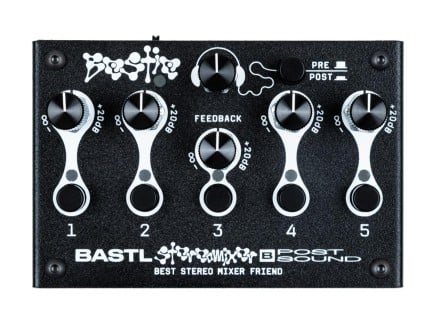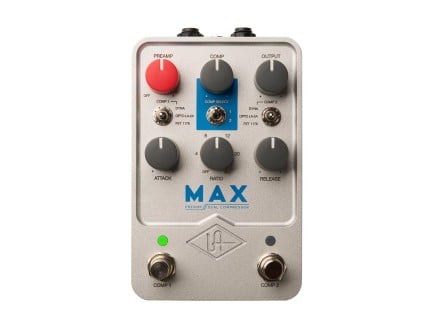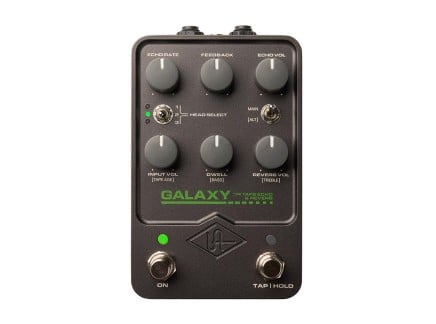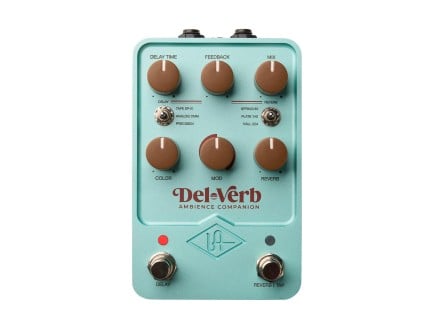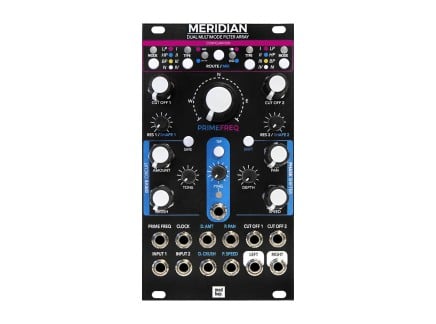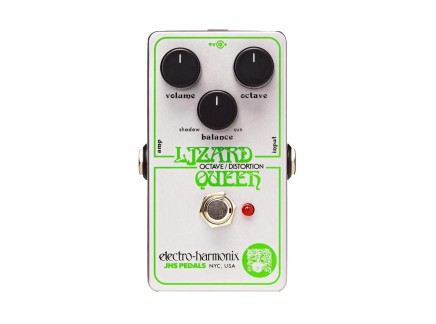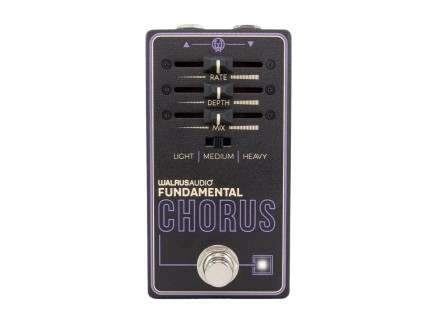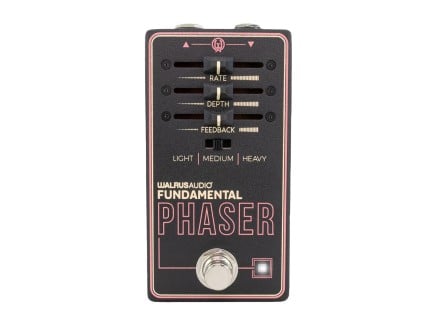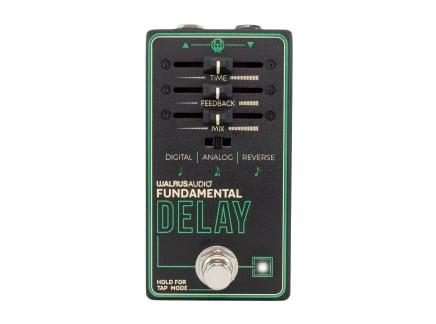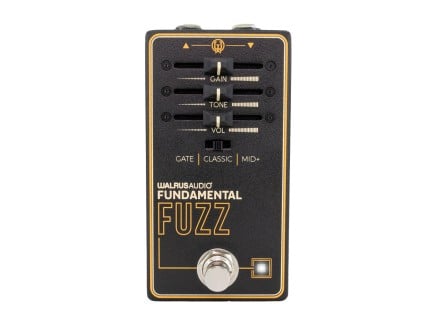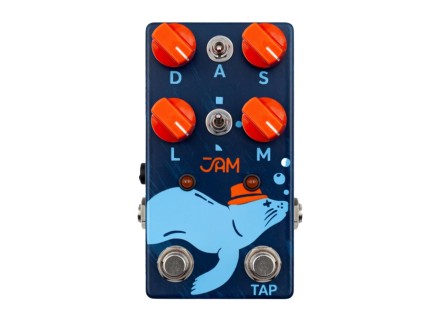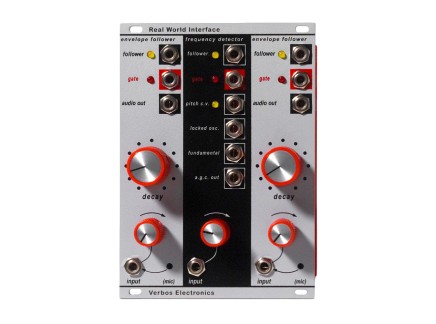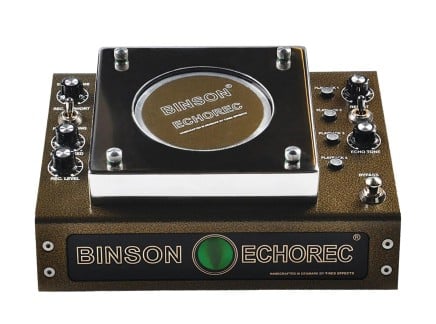NAMM is back! It's that wonderful time of year when music gear manufacturers come together in sunny Anaheim, California to show off their latest creations. As such, we always keep a close eye on NAMM out of excitement: it's often where the most exciting new developments in music technology are revealed. If you're into effect pedals, synthesizers, modular synths, studio recording equipment, or virtually any music-related gear, it's one of the biggest events of the year.
In this article, we're taking a closer look at some of the latest product releases—some from NAMM itself, some from the days and weeks leading up to NAMM. If you're trying to keep up with the latest gear news, keep your eyes here: we'll be updating this article as we learn more, so keep coming back to check on the latest developments!
Intellijel Cascadia: the Long-Awaited Semi-Modular Synth is Here
While they may not be at NAMM this year, Intellijel is still making waves this week with the announcement of their long-awaited semi-modular synthesizer: Cascadia—and it is available to order now. Thoroughly complete as a standalone instrument, you'd be hard-pressed to find a more capable instrument in a single semi-modular package. It may be proud of its heritage in the sounds of the Roland SH-101, but Cascadia extends its vocabulary well beyond that sonic dialect.
Cascadia is a patchable monosynth that can do practically do it all: through-zero FM, filtering, wavefolding, and ring modulation are only a few of its capabilities. There's even an external effects loop for you to incorporate your favorite pedals, coaxing even more sounds out of Cascadia. Built-in MIDI-CV conversion with plenty of configurability means that Cascadia is ready to drop into your studio, speaking with all manner of controllers, sequencers, and DAWs.
Intellijel set a new standard for utilities in Eurorack, and Cascadia continues this trend with an abundance of ways to scale, split, mix, and modify audio and control signals. Its envelope generators are one of the few digital elements in an otherwise fully analog instrument, but you'll find that this allows Cascadia can produce some pretty wild control voltages! From ADSR-style envelopes with an additional hold stage to LFOs, burst generators, and chaotic random, there's no shortage of ways to trigger and shape Cascadia's sounds. You can even use the Intellijel Config App (available for Mac and Windows computers) to configure some of Cascadia's deeper settings to your personal taste, such as the shape of Burst envelopes and the flavors of alternate noise generators.
Intellijel's modules have always been about flexibility and versatility, and even as a standalone instrument Cascadia proves no exception to their core philosophies. If you're looking for the full breakdown, as well as our interview with Intellijel's lead designer and founder Danjel van Tijn, then we definitely recommend checking out our dedicated Cascadia article.
Your New Bestie from Bastl
Bastl retired their long beloved compact mixer, Dude, a few months ago reassuring us all that there would be something to replace it. Well, they have delivered with the Bestie, a collaboration with Casper Electronics, and it is a thing of beauty: 5 Channels of stereo I/O, Cue output, and a built-in feedback path pushes this beyond the realm of utility into the territory of a creative instrument. Powered by batteries or USB-C, this portable acquaintance will quickly rise through the friendship category and straight to the coveted title of Bestie.
Using low noise preamps and housed in a rugged metal exterior, Bestie is a portable, high-quality mixer when you need it to be. Being Bastl, they also added an outrageous +20dB of headroom and gain that can give you that gnarly saturation the Dude was famous for. Bastl heard the call of the noise maker and turned the center, third channel into an internally normalized feedback path that feeds the entire mixer back into itself. This is one of the coolest features as it means you can use this incredibly easily as a no input mixer.
Bastl just keeps making hit after hit and with the Bestie being one of the only compact battery powered mixers available, and the only one with a built in feedback path, it is an instant classic. Rugged enough for your park show and small enough for your studio, we can't wait to create some strange chaos.
Top-Tier Effect Pedals: Universal Audio's New UAFX
Universal Audio has just introduced the newest additions to their UAFX pedal lineup. Their previous pedals have showcased some of their most-loved effects—packaging the top-quality DSP and analog modeling from their world-renowned plugins into a series of effect pedals suitable for use with guitars, synths, drum machines, and studio equipment. Ranging from expansive reverbs to uncanny amp modeling, these have become some of our top picks for pedals based on their sheer sound quality alone. The new trio, though, add even more value to the lineup.
The first of the three, Del-Verb, is described by UA as an "ambience companion." It is a combination reverb/delay pedal that borrows algorithms from both the Golden and Starlight pedals with a more streamlined interface—turning it into the ultimate end-of-chain delay/reverb combo. You'll get instant access to Echoplex-style tape echo, BBD-esque analog-style delay, and precision digital delays for all flavors of echo. On the reverb side, you'll find amp-like spring reverb, EMT-esque plate reverb, and Lexicon-inspired digital reverb tones for creating everything from subtle bounce to epic spaces.
Dressed in a very intentional black and green, the Galaxy '74 is a tape echo and spring reverb pedal inspired by some of the most iconic tape echo boxes of yore. With a super convincing model of the original Space Echo's preamp characteristics, multi-head functionality, and even configurable settings for tape age, this pedal will have you self-oscillating and soundscaping in no time. Based directly on their lauded Galaxy plugin, this is easily one of the best tape echo emulation pedals on the market.
Lastly, the Max is a combination preamp + dual compressor that combines some of Universal Audio's own most iconic processors into a single stompbox...with some other goodies added in for good measure. You get a preamp section modeled after the UA 610, a tube-based preamp/EQ great for everything from subtle coloration to thick sonic grit. The two compressors can be routed in parallel or in series, and each offer (independent!) selection of one of three compressor models: the FET-based UA 1176, the tube-based LA-2A, and the classic red-box DynaComp. Combined? You can do everything from soulful guitar sustain to absolute sonic smashing in true stereo. If you're looking for creative ways to manipulate dynamic control, this is one of the coolest pedals available.
Altogether, these are three amazing additions to UA's pedal lineup, and we expect they'll find a welcome place in many guitar rigs, studio reamping kits, and live synth/drum machine performance setups. (Be sure to check out our full review of the new UAFX pedals for more info!)
Handheld Production Workstation: Polyend Tracker Mini
Polyend presents a brand-new take on one of their most-loved products: the Tracker, a portable sample-based workstation that adopts the general workflow of '90s–'00s tracker-style software in hardware format. The original Tracker has made a huge splash, equally capable of acting as a solo instrument or the brain for a more complete setup. Now, we're introduced to the Tracker Mini: an even smaller version that refines the sound and workflow of the original to create a unique new music creation experience.
Designed to help you make an album anywhere, Tracker Mini is a portable, standalone audio workstation. It gives you eight tracks for stereo audio and MIDI sequencing; it includes audio over USB functionality, a built-in mic, a built-in battery, and it's jam-packed full of sampling and sound manipulation tools for turning any sound into something completely new. It includes an enhanced audio path for higher audio quality, and you get four times the sampling memory of the original. Plus, the audio over USB and MIDI functionality make it great for use in hybrid setups—truly tying the proverbial room together.
Tracker Mini has everything you need to make music built right in. You can add your own samples via microSD (or the included USB to microSD adapter), or you can record straight into it via the built-in microphone. You can easily trim/edit samples and convert them into instruments—heck, you can even use wavetable and granular synthesis to turn your samples into entirely new sounds altogether. You get eight tracks of sequencing (up to 128 steps per sequence), instrument parameter automation, beat slicing, and Song mode for chaining patterns into complete tracks. At a fraction the size of the original with increased sound quality, a solid build, and extensive connectivity options, it feels like a no-brainer: the Tracker Mini is a pint-sized powerhouse for portable music production.
Golden Master + Ghost go Standalone: Effect Pedals from Endorphin.es
In a surprise announcement, Endorphin.es has revealed two new effect pedals based on their Golden Master and Ghost modules. Optimized for live electronic music performance, these pedals accept a wide range of input signal levels...making them great for use with guitar, synths, drum machines, and more.
The Golden Master pedal is a multi-band processor...capable of performing EQing, compression, and mid-side processing. It features 96kHz, 24-bit audio I/O with 32-bit internal processing, along with high-impedance inputs and pseudo-balanced outs: so, you can use it as a high quality audio processor or even just as a DI-box on stage! Each of the three audio bands (low, mid, high) gives you a stereo enhancer and a one-knob compressor, with a global threshold control for easily achieving rich, full sounds. It includes a dedicated expression input for master volume control, and the two built-in footswitches allow you to select presets and bypass with ease. Designed to sit at the end of your signal chain and glue everything together, the Golden Master pedal will no doubt prove a powerful companion to many a pedalboard and standalone setup, much in the way its modular counterpart has for many Eurorack systems.
Ghost, originally a Eurorack module developed in collaboration with Andrew Huang, now also sees its pedal-format debut. This multi-dimensional Effects Chain Processor goes far beyond the capabilities of a typical multi-effect pedal. Offering filtering, distortion, delay, and reverb with a huge number of routing options, it's the perfect way to add everything from lush, spacious ambience to absolutely crushing decimation into your pedal rig. You get access to spring, reverse, or hall reverbs; comb/resonator, bandpass, and combo highpass/lowpass filtering; and you get access to six routing configurations for extensive sound design options. You'll also get reverb freeze, delay looping, and virtual spring excite for the spring reverb model—pretty rad.
The bipolar LFO and expression pedal can be routed to any parameter. The streamlined user interface includes LEDs next to each knob, allowing you to visualize the current parameter settings and modulation in real time. You get full MIDI control of every parameter (!!) as well, making it a great choice for desktop or computer-based hybrid setups. The three footswitches may additionally be assigned to many parameters (tap tempo, freeze, spring excite), and you can select presets and bypass directly with the footswitches for hands-on (or feet-on?) control. You get line or high-impedance JFET inputs, so it's easy to use with synths, drum machines, guitars, you name it!
Though unexpected, we're quite excited to see these pedals added to the Endorphin.es lineup...and we're especially excited just to see more modular manufacturers breaking out into more standalone hardware design. These are solid entries into the world of standalone effect processing, and they bode well for the future. Currently, the Ghost and Golden Master pedals are anticipated to be available Autumn 2023; prices are not yet confirmed.
Flexible Eurorack Filtering with Modbap Meridian
Modbap makes great modulus that occupy a specific role in unique ways and with the Meridian, they give us a dual channel multimode filter that also offers some nice grit. There are so many filters inside of Eurorack, so it's hard to make one that offers something unique, but Modbap has done just that. Easily flip between four different filters and four modes and use the internal routing for series or parallel.
The central knob is a macro control for the two Cutoffs which makes generating wide stereo fields very easy. Connected and co-dependant, these two filters can elevate your sound as a fantastic end-of-signal polish. Using it to affect sound, too, is great thanks to the independent Drive and Phase Shifter circuits that can add some character to your pad, lead, or anything else you throw at it. Along with being Ping-able, meaning you can get some nice resonant plucks out of it.
The Meridian is a welcome addition to not only the Modbap family, but Eurorack writ large for its versatility and ability to manipulate stereo signals. With clear labeling and an ergonomic design, this can easily be the only filter you need. Combined with their Transit mixer, Per4mer, or any of their other modules and you have a rack of good looking, good sounding fun.
An Unexpected Collaboration: EHX/JHS Lizard Queen is Real!
The story of how Lizard Queen, the EHX and JHS collaboration pedal, came about isn't your average product development story. As a longtime fan of Electro-Harmonix, Josh Scott teamed up with graphic designer Daniel Danger to craft an homage to the 70s style and sound of EHX. The resulting pedal, Lizard Queen, had such a commanding sound that appealed to guitarists and bassists all over. So much so that EHX couldn't ignore the demand, and teamed up with JHS to put Lizard Queen into production.
So what is Lizard Queen? Featuring an original circuit by Scott, the Lizard Queen is a fixed-gain octave fuzz pedal with super straightforward controls. Set the output level with Volume, blend in the octave up sound with Octave, and fade between two flavors of fuzz with Balance. Its character ranges from smooth to biting, and it surely can enhance any instrument from guitar to bass, synths, and more.
Lizard Queen is delightfully simple, and as a modern throwback to vintage EHX tones and vibes, we think it's a wonderful mix of old and new. It's gnarly, raw, and everything we'd want out of a fuzz pedal—and its affordable price is a nice bonus, too. Honestly, we're here for this unique collaboration between two exceptional pedal brands, and we hope to see more if this in the future.
No-Nonsense, Budget-Friendly Pedals: Walrus Fundamental Series
Walrus Audio recently introduced their Fundamental Series line of pedals: a collection of compact, straightforward, affordable effect pedals. The initial collection of eight pedals each focuses on a specific classic effect, providing three modes of operation and three variable controls. Let's take a look at the whole series, breaking them up in to distortion effects, modulation effects, and spatial effects.

There are three distortion-based pedals in the Fundamental Series: the Fundamental Drive, Fundamental Distortion, and Fundamental Fuzz. Fundamental Drive provides a wide range of drive tones, thanks in large part to its three-position switch...which gives you access to three fundamentally distinct flavors of overdrive. Smooth mode gives you classic soft clipping silicon overdrive; Crunch mode brings in additional hard-clipping silicon diodes and a low-end boost for an edgier tone; Bright mode maintains the silicon soft and hard clipping stages, but applying a pre-clipping low cut for a brighter, glassier tone. From there, you get gain, tone, and volume controls, providing continuous variation for each of these distinct sonic flavors. The Fundamental Distortion keeps the gain/volume/tone controls, but provides different styles of distortion and clipping: Dark, and asymmetric silicon clipping; Si, classic silicon hard clipping; and LED, using LEDs as clipping diodes...all of which provide a generally crunchier, more aggressive sound palette than the Drive pedal. Finally, the Fundamental Fuzz also gives you three distinct tonal options: Gate, a classic gated, fizzy, voltage-starved sound; Classic, a screaming fuzz with mid scoop for a compressed, crunchy tone; and Mid+, which results in a fuller fuzz tone.
The Fundamental Series also includes three modulation pedals: the Fundamental Tremolo, Fundamental Phaser, and Fundamental Chorus. Fundamental Tremolo is a classic, chewy-sounding optical tremolo with continuous controls for volume, tremolo rate, and tremolo depth. With the choice of sine, square, and stepped random volume modulation, it's great for everything from smooth, subtle swells to wild, glitchy amplitude modulation tones. The Fundamental Phaser provides continuous control of the phaser rate, depth, and feedback amount, with mode selection for light, medium, and heavy flavors for everything from subtle shifts to swimming experimental tones. The Fundamental Chorus (one of our favorites of the lot) gives you rate, depth, and mix controls...again, with a selection for light, medium, or heavy chorusing effects. Everything from traditional warm sweeps to heavy tri-chorus-esque tones are easily available.
Finally, the initial Fundamental Series lineup includes two spatial effects: the Fundamental Delay and Fundamental Reverb. The Fundamental Delay gives you delay time, feedback, and mix controls, with selection of analog-esque, clean digital, and reverse delay modes. The selection switch also offers the secondary control of tap tempo subdivision selection, great for creating tempo-synced echo effects. The Fundamental Reverb gives you controls for decay, tone, and mix, with selection of Hall, Spring, or Plate reverb models.
All in all? The Fundamental series provides excellent bang-for-your-buck. These excellent-sounding effects are a perfect choice for anyone building out their first pedalboard, or anyone looking for some great-sounding, no-nonsense effects to fill in the gaps in their current pedal selection. If you're looking for some affordable, awesome pedals that deliver exactly what they promise, the Fundamental series is one of our top picks. (Be sure to check our our full review of the Walrus Fundamental Series pedals!)
Jam Pedals Harmonious Monk MkII: Harmonic Tremolo Refined
JAM is a company that has come out swinging with a lineup of pedals that look great and sound fantastic. One of their most popular is the Harmonious Monk harmonic tremolo, and they have released a second version that includes some commonly-requested features while keeping the same great sound. That means, the all analog signal path stays the same, and the two modes—harmonic and amplitude—also remain the same.
The changes include a Tap Tempo footswitch, making it easy to have a dynamic tremolo without having to adjust the settings. JAM also decided to include an option to have the TAP footswitch engage a Ramp feature that lets you move from one tempo to another, with the ramp speed being fully adjustable. Flip back to the Legacy Mode if you don't want the extra Tap/Ramp, with the additional feature of moving from either 1x speed to 2x or 1.5x speed at the press of a button.
The final addition to the new Harmonious Monk pedal is a new reverse sawtooth waveform in addition to the sine and square. With these options, plenty of subtle and choppy sounds are just a tweak away. JAM just keeps cranking out hit and after hit, and we are stoked to see what's next.
Streamlined Classics: 4MS's Looping Delay and Sampler Eurorack Modules
4MS has introduced simplified versions of two of their most popular modules, the Dual Looping Delay and Stereo Triggered Sampler. Now presenting the simple Looping Delay and Sampler modules, you'll have options for more streamlined, affordable versions of these classic Eurorack effects. Even better, they plan to release these new models both as preassembled units and as kits—so if you're DIY-inclined, you can get a great deal on some awesome modules.

The Looping Delay is a remarkably clean, clear delay effect with tight clock sync and up to 87 seconds of delay time. Because it can be so accurately tempo-synced, it's great for use creating rhythmic echoes or for looping effects. You have a built-in tap tempo control, or alternatively, you can send in an external clock. The Time control gives you access to multiples or subdivisions of the tapped or incoming clock, so it's simple to dial in any echo rhythm you want. LD includes an external feedback loop for inserting effects in the delay line; it also offers voltage control of delay time, feedback, and mix. You also have dedicated buttons and trigger inputs for Hold/infinite feedback and Reverse modes. When in infinite hold, you can use the knobs and CV to "window" around the delay memory, shifting the currently audible loop. You also get a clock out and loop clock output, great for synchronizing note and phrase-level events to the delay itself. All in all, it's a great module that packs tons of utility into a small size at an excellent price.
The Sampler is a mono-or-stereo sampling/sample playback module. It can either source its samples from incoming audio, or from .WAV files on the included SD card—making it a great way to bring outside sounds into your Eurorack setup. You can hold up to 600 samples (60 banks of 10 files), so you'll have access to a huge range of new sounds in no time. What's more, it ships with hundreds of samples on the included card...so you can get right to making sound immediately.
Sampler gives you control of sample playback pitch, start position, and length, each under manual and voltage control. By combining the length and start position controls, you can achieve pseudo-granular effects, great for glitching, stuttering rhythmic bursts. There's also a dedicated reverse playback button and trig input, great for further scrambling/mangling your sounds. Add to this the ability to select samples under voltage control and to synchronize other modules via the End of Sample output, and you've got a module that turns a simple concept into something creatively compelling and inspiring.
Sampler and Looping Delay are expected to be available in late June 2023, with a street price of $299 and $275 respectively (for the assembled modules).
Audio Control for Your Eurorack Systems: Verbos Real World Interface
The Verbos Electronics >Real World Interface is a Eurorack module that serves two main purposes: amplifying external audio for use in your modular system, and extracting control voltages from external sounds. All in all, it's a way to use audio from other sources—or from within your system—to trigger events or shape signals within your system. As big fans of envelope following and pitch detection modules, we're super stoked to see Verbos's take on these super useful synthesis tools.

Like most Verbos designs, the Real World Interface presents a unique spin on a couple of classic Buchla modules. It offers three channels, each arranged roughly like a channel strip; the left and right channels are identical to one another, and the middle channel offers some extra tricks. The two outer channels are envelope followers, in the style of the Buchla 230 Triple Envelope Follower. You get an audio input, a gain/sensitivity control, an audio output, and dedicated envelope follower and gate outputs: the envelope follower out produces a signal proportional to the input signal's amplitude, with the gate firing at the onset of significant musical events. The envelope followers have variable decay time, for everything from super tight, immediate following to slower, more sluggish releases. Each of these two channels also has a built-in condenser microphone normalled to their inputs, so you can generate gates and CV simply by tapping the module, or capturing the energy of nearby sound sources. Pretty rad.
The middle channel, though, offers a number of other even more exotic functions. Modeled after the (quite rare) Buchla 232 Frequency Detector, this section still provides a gain control and envelope follower/gate outputs...but additionally, it produces a number of extra outputs for signals that ultimately work together to produce a pitch CV output from external input signals. Going from bottom to top, you'll get: an AGC (automatic gain control) output, a sort of compressed version of the input signal; a fundamental extractor signal (which uses a tracking lowpass filter to produce only the fundamental of the input signal); a phase-locked oscillator output (great for audio-driven gnarly synth tones); and finally, a pitch CV output for using external sound sources to control your Eurorack oscillators, samplers, and more.
Audio feature extraction is one of the most interesting and little-talked-about aspects of Buchla's classic 200 Series instruments; and we're thrilled to see Verbos take on some of these concepts for use in modern music-making ecosystems. You'll be able to use your instrument(s) to trigger and shape your Eurorack signals; you'll be able to turn your voice into a synth tone; you'll be able to generate rhythms from your surroundings. All in all? It looks like it'll be one heck of a fun way to interact with your modular system.
The Real World Interface is currently expected to ship in August 2023; price is still to be determined.
T-Rex Binson Echorec: a Classic Effect Reimagined

T-Rex has finally unveiled their long-developed, much-ballyhooed revitalized version of the classic Binson Echorec. The original uses a magnetic wire on a rotating drum to create delay and reverb effects, and T-Rex has created a more compact, modern version of this same motorized cycloptic centerpiece. Complete with the glowing Magic Eye and woozy Swell setting, this unit is a labor of love—and you can hear it from the first rotation.
T-Rex modernized the components, but still keeps the entire thing analog and handmade. They've eschewed two of the recording heads in favor of a simple Short and Long switch, with the Long setting being identical to the original's fourth record head length. They had to keep the four playback heads, though, and with those you get the same push button interface as you did on the original for any combination you'd like.
The most incredible addition is the Speed control, which lets you adjust the speed of the drum +/- 20%, which you could not do on the original. This speed control is also controllable via an expression pedal for a dynamic, trippy experience. An Echo Tone control lets you adjust the color of the audio, and with Balanced outputs, this is a premium audio device. T-Rex has created their crown jewel with the Binson Echorec and it is sure to be a favorite amongst...well, everyone.
Death by Audio Disturbance: Modulation to Rip Your Face Off

Death by Audio creates truly dosed effects and we were stoked to see that they have come out with a new pedal, the Disturbance. This is a modulation pedal that packs in three different modes: Filter, Flanger, and Fazer with the unique property of being centered around a lockable LFO. Packed with all the controls you'd expect for intensity, width, and center frequency, this is sure to be a crown jewel for any board.
A Lockable LFO means you can unlock expert levels of expressivity by using the Trip footswitch to start or stop the LFO. No matter what mode you're in, you can stop the LFO on a dime and lock in that filter frequency, luscious faze, or freaky flange. Then you start it again—and while that might seem like a strange feature, once you use the CV output that sends the LFO voltage out, you can get some wonderful interactivity with modular gear or anything that accepts control voltage.
The cross-pollination between the pedal world and modular world is inevitable, and with Disturbance, we can see how interesting the possibilities are. Use it with a synth, or other pedals that accept CV (keeping in mind that many pedals' expression jacks can accept CV—but be sure to check the manual, of course). We're not quite sure of final pricing or availability...but keep your eyes peeled for more info!
SSL B-Dyn: Console Sound in 500 Series Form Factor
SSL unveiled the 4K B-Dyn, a 500 series dynamics module based on the beloved 4000 B-Series console. Broken into two sections, you get a compressor section with four ratio settings: 2, 4, 10, and DeEsser, a Threshold control, and stepped Release setting. Choose from four release speeds: 0.2, 0.4, 0.8, and 1.6s—plenty of options for myriad applications. Use the Link setting for stereo use with two B-Dyns.

The second section is Gate/Exp that gives you similar controls with a Threshold and Release, but you also get a Range control. Use the EXP button to get either a 20:1 Gate or a 2:1 Expander. Both sections have an Out setting which will remove the respective section for the circuit completely. Unlike the E-Series, the B-Series B-Dyn has added character and will give you that iconic 80's sound.
Bring a little bit of the 80s to your 500 series rack and add the unique coloration of the 4000 B-Series to any project you're working on. SSL keeps stay relevant, bringing us their class sounds in updated formats and at affordable prices. B-Dyn will undoubtedly give a nice edge and 80s sheen to your sound.
Rossum Locutus: MIDI Control for Assimil8or
The past few years have been hard for instrument manufacturers, but we're finally starting to see things turning around. The folks at Rossum are preparing to ramp up production again in 2023, but at NAMM this year they're already presenting a small but very mighty module: Locutus, a MIDI expander for Assimil8or.

Samplers tend to be among the most deep and complex types of modules in a Eurorack modular synthesizer, but few can match the capabilities of Assimil8or. Now with Locutus, the addition of MIDI In, Out, and Thru allows Assimil8or to more directly interface with external elements of your studio. MIDI controllers, keyboard synthesizers, and direct connection to DAWs allows for new ways to manage and play your samples, including polyphony and other more complex scenarios.
Locutus includes the necessary cable to connect to your Assimil8or, so it's easily added to your rig for more sampler-centric opportunities. We're looking forward to seeing more from Rossum later this year—and congrats to Dave Rossum for receiving a lifetime achievement award during this years 40th Anniversary celebration of MIDI.
NUX Trident: Powerful Multi-Effects
Presenting their latest and great take on guitar-centric multi-effects processing, NUX's Trident boasts their hottest amp modeling technology yet. Internally operating on a dual DSP architecture and featuring a robust aluminum chassis, Trident is thoroughly specced inside and out. 27 amps and a host of effects to choose from means that you've got a variety of tones at your disposal at any time.

Trident is fairly compact as far as multi-effects units go, making it a great choice for live performance and fly-rigs. But thanks to the addition of a USB-C port, it also serves as a cpaavle audio interface, meaning that Trident can be a holistic source of tones in the studio and on the stage. 27 amps and cabs plus four microphones give you enough variety to work with, but not so much to overwhelm with needless options.
The controls on the unit itself are incredibly straightforward, making it easy to dial in great-sounding tones. Dedicated knobs for the amp section, as well as controls for different effects blocks keeps things instantly accessible. But if you want or need a little bit more, Trident's companion software allows you to edit patches with a graphical interface, load in your own IRs, and set up USB configurations for direct recording.
There's still much more to Trident: MIDI control, an external effects loop, and a 60-second looper round out the package for an all-encompassing guitar tone solution. Availability is expected later this year, with price estimated to be just under $500.
IK AXE I/O One: New Interface for Guitar + Bass
IK Multimedia has been developing a number of guitar-focused products for years, and AXE I/O One is the latest entry into a line of interfaces designed specifically for guitarists and bassists. It's a highly streamlined interface with a single input, but packs in a number of additional features and conveniences that make it worth consideration in any studio working with guitars.

AXE I/O One features what is perhaps the most thoughtfully designed guitar preamp section of any interface on the market. Not only do you get gain and phantom power for condenser microphones, but a number of switches and controls additionally sculpt DI guitar signals for premium results. Flip the Active/Passive switch to correspond with your instrument's pickups, engage the JFET preamp stage for a bit of extra spice, and pull the best tone out of your pickups with the Z-Tone impedance control.
Of course, AXE I/O One is an audio interface, so it features plenty of standard features, too. 5-pin MIDI I/O lets your synths and controllers get in on the recording fun, and balanced audio outputs for your monitors allow you to actually hear what you're doing! Another nice addition is the Amp output, which lets you pass your signal on to an amp in the room.
That's It...for Now
NAMM might be over—but be sure to keep your eyes peeled on our blog—Superbooth 2023 is just around the corner, and we have a feeling that we'll be seeing an awful lot of exciting new synths, Eurorack modules, and more! Until then, keep it real!


